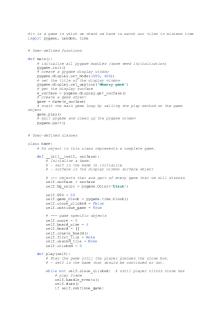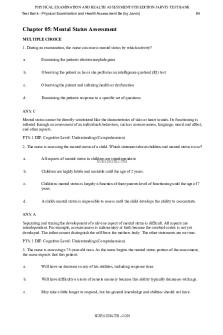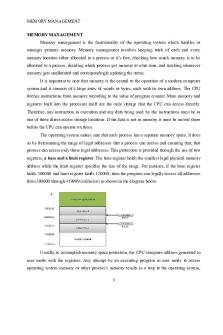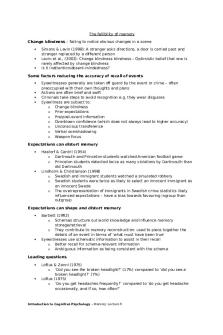(5) Memory & Mental Availability PDF

| Title | (5) Memory & Mental Availability |
|---|---|
| Author | Naomi Rayo |
| Course | Buyer and Consumer Behaviour |
| Institution | University of South Australia |
| Pages | 7 |
| File Size | 396.5 KB |
| File Type | |
| Total Downloads | 24 |
| Total Views | 137 |
Summary
Lecture notes...
Description
(5) Memo morry & Men Mental tal Avai Availa la lab bili ility ty Tuesday, 10 November 2020
11:59 AM
Brand should be a good example of the category Buyers: ▪ Habitual ▪ Repertoire-buying. Repertoires varies from person to person ▪ Loyal to an extent i.e. Polygamous loyalty, more loyal to some brands than others ▪ Satisficing, seeking the 'good enough' option. Busy people, don't care much about the brand ▪ Some brands are more thought of or noticed than other brands i.e. Bigger brands, mental and physical availability
Me Mem mor oryy /noun/ Result of a network of neurons stored in our brain. A combination of neurons and chemicals interacting with each other.
Most of our mind is unknown i.e. How it works, but we do know most physiological but not the 'mental' works. ▪ A lot of what we know is from studying when thing go 'wrong' e.g. Mental illness Rational vs Emotional side of our brains ▪ Works together in decision making ▪ Buying Decisions: 20% rational and 80% emotional ▪ Emotional side always wins/overpowers the rational to simplify rationalising and make progress with decision-making ▪ Only so much information we can take-in for buying decisions - satisficing ▪ There needs to be a balance of informative and emotional in marketing
3 Areas of storage: Sensory ▪ Immediate ▪ Memory as we see, touch, feel, smell, and hear it ▪ Sometimes moves to short-term memory ▪ Once the stimulus is gone, so is the memory ▪ Passes in & out of consciousness quickly - takes less than a second to process ▪ Hard to verbally describe ▪ Can be trained i.e. Trained to focus & ignore sounds Short-Term A.K.A Working Memory ▪ Aids memory by creating links & association to help recall ▪ Actively trying to remember & filter what information is important to encode into brain ▪ Temporary storage i.e. At some point the memory is lost ▪ Passive process
CB Page 1
▪ Capacity is 5 to 9 items i.e. 7 with +/- 2 standard deviation ▪ Enhanced by "chunking" or dividing information into sections to absorb & process information easier and for easier recall ▪ Stored in more "vulnerable" form i.e. Easily lost when injury occurs ▪ Clinical conditions and Age also impacts short-term - less efficient ▪ Like computer files - smaller files, easy to store ▪ Culture impacts memory i.e. Chinese people remember more information as they have the shorter words for digits Long-term ▪ Thought to be relatively permanent ▪ Nothing is forgotten, only the means of retrieval is lost ▪ Usually the things we can retrieve from long term memory are ‘events’ rather than every day things ▪ Sensory memory i.e. The stimulus plays a role to create link for retrieval ▪ Certain stimulus or cues help trigger the memory
○ 3 areas of memory storage: Sensory, short-term, long-term ○ 3 processes involved in memory: Encoding, maintenance, retrieval ○ What information do we store in our memories re brands: brand name & attributes ○ How are brands retrieved from memory: cues Memory is associative i.e. Links with other memories - more links, easier recall 4 Basic principles Relates memory to buying behaviour 1. Information stored as nodes 2. Nodes can be linked together i.e. 'associated' 3. These links are bi-directional 4. Links give a chance at retrieval, improves chances not ensures retrieval Associative Network Theory: Maps out links & associations with brand & name Memory is probabilistic & prone to error - efforts to 'fill in gaps' when we can't remember something. Our memory is fickle. THEREFORE marketers must aim to strengthen links for higher chance of retrieval.
Long-Term Memory Explicit With conscious recall ➢ Episodic - Personal experience, real-life experience. As a brand, we want to attach our brand to common experiences ➢ Semantic - Memory for words, concepts, and general ideas. General knowledge about the world and ourselves e.g. We know our age without having to count, McDonalds sell burgers and fries. Implicit
CB Page 2
Without conscious recall ➢ Priming - Activating a particular association or representation in our memory before conducting a task e.g. Somebody sees the colour purple while walking down the confectionary aisle - more likely to remember or spot Cadbury. ➢ Procedural - Motor skills, knowing how to do things
3 Memory process Encoding ▪ Putting information into storage ▪ Form links with information already in memory or reinforce existing knowledge we can form new memory based on current information in our brain e.g. Trying to understand new species by describing it with other items were know that looks like it ▪ Can be conscious (e.g. Memorising) or unconscious (e.g. Repetitive exposure) learning ▪ We filter out a lot of info and have selective attention (At a party - always hear our own name - regardless of the noise) ▪ Must be encoded in a particular way in order to be retrievable ▪ How deep and method of encoding (e.g. Amount of time spent and how it is memorised) impacts retrieval of memory Implications Buyers filter out most of what they are exposed to i.e. Rational vs emotional Buyers notice: ○ Brands or categories that are useful/important ○ Unusual or surprising, breaks through clutter ○ Frequently used i.e. Relevant to users ○ Brand and ad recall most likely to occur for users of the category and brand i.e. USAGE IMPACTS RECALL ❖ “Consumption” is typically more important than “buying” ❖ Breaking through the filtering process and gaining attention is crucial ❖ That’s why likeable, engaging ads work - ads that evoke arousal ‘they make you laugh or cry’ - more likely to be watched again ❖ Deeper processing = better retrieval Marketers need to break through marketing "clutter" & for buyers to create link Make it easy for buyers: - Colour - Distinct - Prominent - Symbol Identifiable - Slogan - Style - Consistent Aim to create or reinforce links in memory - knowing the BRAND NAME is crucial - Building distinctive assets
Reusing concepts & themes is okay - can be good to reinforce links & keep recognition of brands.
CB Page 3
Storage Maintenance of memory ▪ The way we ‘keep’ information in memory ▪ Rehearsal can be just repeating the information over and over - strengthens retrieval of memory ▪ BUT elaborative rehearsal - with exercises such as linking new information to other items seems to work better ▪ Reinforcement of links & memory Implications BRAND NAME - Most important attribute for consumer to remember ➢ Cues & links with brand to help with retrieval of brand ➢ Brand Attribute - direct links to brand ➢ Cues used for retrieval - link the items to brand ➢ Anything encountered in the same context as the brand get stored in the memory
Retrieval ▪ Cue based - cue is anything in the environment that trigger the retrieval ▪ Linked info can be retrieved and used or acts as a retrieval cue for further information ▪ Factors such as mood can also effect retrieval ▪ Not everything linked will be retrieved - we don’t have the mental capacity or inclination ▪ Attaching as many links and associations to increase the amount of cues, higher chance of retrieval for the brand Implications Cues can be: ▪ A wide range of brand attributes, it can also be how people think of brand i.e. Attitude towards brand, experiences and feelings e.g. Cool down ▪ Product category i.e. The brand MUST be a good example of category E.g. Strong link between Cadbury & chocolate
Retrieval cues varies from person to person. Therefore it's important to know the links consumers have of the brand & their perception to know which cues and links to include into advertisements/marketing
Forgetting - why does it happen 1. Ineffective initial encoding i.e. Not enough elaborate comprehension) 2. Decay: Memory fades with time, no maintenance to ensure salience 3. Interference: competition from other information 4. Different context cues, association & context is different for each person
Men Mental tal Avai Availa la labi bi bililility ty A.K.A Brand Salience, all things talked about is to build mental availability The presence of the brand in our mind - size depends on links/relevance
CB Page 4
○ The propensity of the brand to be thought of or noticed in buying situations ○ This is reflected in quantity and quality of the network of brand information in memory ○ The more cues that the brand is linked to, the more likely it will be linked to the cues the customer is likely to come across in buying situations ○ The more CEPs/cues that the brand is linked to, the more likely it will be linked to the cues the customer is likely to come across in buying situations ○ The most important thing that marketing managers need to be concerned about Real challenge is to CREATE AVAILABILITY - both M.A and P.A are important
What IS NOT Mental Availability Brand Attitude The focus is on evaluation of the brand rather than the quantity and quality of the memory links to the brand Top of Mind Awareness The first brand recalled when prompted with the product category cue Mental Availability considers multiple entry points (cues) to retrieve the brand from memory, not just evaluative attributes or the product category cue. Why do buyers store information about brands in memory: ▪ It's useful & helpful ▪ Makes it easier to buy the next time - don't have to learn from scratch ▪ Learning is hard work - no one wants to do it all the time, saves time
Measuring Brand's M.A Measuring a brand's Mental Availability. Reasons why consumers enter the category 1. It should contain a range of Category Entry Points (CEPs)/ cues used to ‘think of brands’ within the relevant category. CEP’s are: • pathways to the brand • ‘distribution outlets’ in the mind of consumers • building blocks to mental availability Measure M.A buy running surveys - setting up the survey depends on the CEPs, asking respondents which CEPs remind people of the brand - capture which ones people actually use in real life Can be: ○ Purchase situations e.g. At the shop ○ Consumption situation e.g. For the party ○ Environment the buyer is in e.g. At the beach ○ Who else is present e.g. With kids ○ Needs e.g. Cool down ○ Core benefits the category can offer e.g. Filling snack
CB Page 5
2. It should focus on retrieval rather than evaluations of a brand • Either the brand is retrieved or not when prompted with a cue (e.g. tasty) rather than the extent on a rating scale to which it applies to a brand Not what they think of brand but rather what comes to mind when they think of brand - BI DIRECTIONAL i.e. Also what reminds them of the brand
3. It should measure recall relative to competitors rather than for a single brand independently/individual brand ○ What links are associated with competitors ○ Spotting which cue you can use on your brand and which cue to strengthen
Implications for Marketing ➢ Retrieval from memory is cue based, cues come from the external environment and our internal thoughts (sometimes at the same time) ➢ Marketers need to understand and consider the cues buyers use when they think of options to buy ➢ Marketers need to build brand’s mental availability, so there are many cues, prominent and fresh cues that link to the brand. ➢ If the brand is not thought of in a buying situation it can’t be bought
Implications for Competition ➢ Just because your brand is thought of for one cue, doesn’t mean it will be for other cues - varies across people, look at aggregate & which is most prominent ➢ View competitors from a buyers’ eyes rather than just a competitor ➢ Realise this competitive set may vary by situation, over time etc - how brand is thought of may vary over time THE BIGGEST CHOICE FOR BUYERS IS WHETHER OR NOT THEY NEED TO BUY FROM THE CATEGORY.
CB Page 6
Memory & Mental Availability - Tutorial Questions 1) What is mental availability (also referred to as brand salience) and how does it relate to buying situations? Mental availability is the likelihood of a brand being thought of or noticed across a range of situations and needs that buyers of the category encounter (Romaniuk & Sharp 2016). This relates to buying situations as the strength and breadth of a brand’s mental availability will determine the likelihood that a buyer will purchase that particular brand. Mental availability is built from both category entry points (CEPs) and cues (Romaniuk & Sharp 2016). The stronger the links to CEPs and cues, and the more CEPs and cue links that a brand has, the higher the chance that the buyer will purchase the brand in a buying situation 2) Describe the process of a brand being stored into memory?
The process of a brand being stored includes 1. Encoding – Receiving information relating to the brand and encoding this information a particular way in order to be retrievable in the future. Either done consciously or unconsciously. Usually the brands noticed are useful, unusual, or frequently used and relevant. Making marketing efforts (e.g. advertising) attention-grabbing and likeable can help with effective encoding so that it’s easier to retrieval the brand later on. 2. Storage – Where the encoded information is kept. The most important information to be stored about a brand is its name. Using the right and relevant cues and CEPs, such as brand attributes, will help trigger retrieval of the brand later on. As memory fades over-time, it is important to keep this information fresh, relevant, and strong by reinforcing the brand’s memory links 3. Retrieval – Through the use of cues, consumers are able to retrieve the brand when exposed to the particular cues. These cues can be brand attributes. CEPs are also used for retrieval and for this to be effective, the brand must be a good example of the category in order to be easily and frequently retrieved from the memory. If it’s not relevant to the category, it will be hard for consumers to remember the brand when needed. This emphasises the importance of learning what the relevant and effective cues and CEPs are.
CB Page 7...
Similar Free PDFs

(5) Memory & Mental Availability
- 7 Pages

Topic 5 Learning Memory
- 13 Pages

Chapter 5 Memory
- 6 Pages

Physical Availability
- 4 Pages

Memory
- 3 Pages

Memory
- 5 Pages

Actividad 5 Mapa Mental
- 5 Pages

2021 UIC SBUX Availability form
- 2 Pages

HIGH AVAILABILITY IT SERVICES
- 527 Pages

MAPA Mental. Grupal (clase 5)
- 2 Pages

Ensayo Salud mental - Nota: 5
- 3 Pages

CH 5 Mental Status Assessment
- 16 Pages
Popular Institutions
- Tinajero National High School - Annex
- Politeknik Caltex Riau
- Yokohama City University
- SGT University
- University of Al-Qadisiyah
- Divine Word College of Vigan
- Techniek College Rotterdam
- Universidade de Santiago
- Universiti Teknologi MARA Cawangan Johor Kampus Pasir Gudang
- Poltekkes Kemenkes Yogyakarta
- Baguio City National High School
- Colegio san marcos
- preparatoria uno
- Centro de Bachillerato Tecnológico Industrial y de Servicios No. 107
- Dalian Maritime University
- Quang Trung Secondary School
- Colegio Tecnológico en Informática
- Corporación Regional de Educación Superior
- Grupo CEDVA
- Dar Al Uloom University
- Centro de Estudios Preuniversitarios de la Universidad Nacional de Ingeniería
- 上智大学
- Aakash International School, Nuna Majara
- San Felipe Neri Catholic School
- Kang Chiao International School - New Taipei City
- Misamis Occidental National High School
- Institución Educativa Escuela Normal Juan Ladrilleros
- Kolehiyo ng Pantukan
- Batanes State College
- Instituto Continental
- Sekolah Menengah Kejuruan Kesehatan Kaltara (Tarakan)
- Colegio de La Inmaculada Concepcion - Cebu



